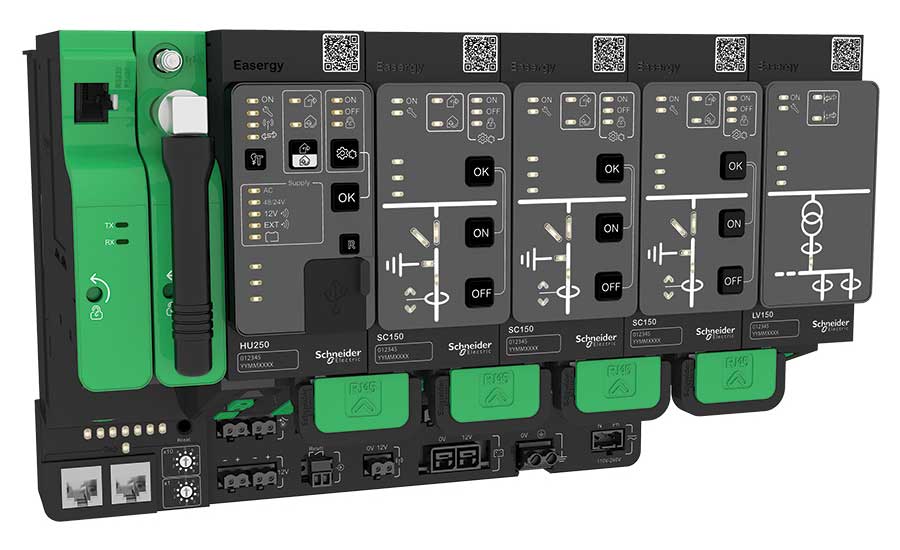Automation Series
Legacy automation systems will soon require replacement
If your plant has a legacy control system, it might be running on borrowed time.

In food and beverage operations, downtime to install all-new equipment can add significant cost to the project overall. This may tip the scale in favor of retrofit in some situations. Source: Bosch Rexroth Corporation.

With advanced controls and IIoT controls, Bühler Aeroglide’s AeroPro Moisture Control can increase production yield for processors by continually monitoring product moisture content at the dryer discharge and automatically adjusting the dryer in real time, providing yield increases and energy savings. Source: Bühler Group.

Technologies like Rexroth’s IoT Gateway allow users to manage and act on the data they collect using a web-based interface without intervening in the automation logic. Source: Bosch Rexroth Corporation.

Upgrading legacy automation system hardware can help simplify maintenance and operations through better visibility and use of data, which can then contribute to future process improvement initiatives. Source: Schneider Electric.




Sidebar
Security: Everyone’s responsibility
Most of the connected hardware and software provided by vendors have security built into them at some level. It is wise to take advantage of this, but it’s also necessary to provide the proper training and access to maintenance, operations and management. It is important to realize that turning security “on” also requires investing in people and resources to manage security throughout the control system lifecycle. For example, there must be a way for maintenance and operations to perform their jobs at 2:00 a.m. when their password has expired. Security systems are ever changing as people, roles and processes change—and someone needs to own making those changes.
Additionally, implementing control system security can require some investment in revising existing network topologies, making sure there is proper segregation between business networks and control networks with firewalls or similar technology, all while allowing the necessary business data to flow down to the controls system and reporting information to flow back up unhindered through the DMZ. This adds another layer of engineering that needs to be considered during the conceptual phase of the project and reviewed with the necessary stakeholders in IT and the system integrator.
—Chris Wahl PE, Stone Technologies.
Sidebar
Legacy systems: Costs and issues
Associated with legacy systems is the higher labor cost to operate processes controlled by these systems. Older existing systems frequently cannot be modified to adapt to process changes due to a lack of working knowledge or no additional expansion capacity. The result can be processes being only partially automated, which requires operators to override the automation at specific points in the process or even to operate completely in manual mode. Either of these slows down production rates, increases labor costs and increases the amount of scrap and rework due to errors when the manual overrides are missed, or manual processes are not executed properly.
Legacy systems are more proprietary, less open and have very limited throughput, making it difficult or impossible to share data, which is increasingly important in improving performance and meeting FDA regulations, including the Food Safety Modernization Act. A key aspect of implementing a modern control system is early implementation of standard networks, such as EtherNet/IP, with standard connectivity and communication rates thousands of times faster than older networks, such as Remote I/O and Data Highway Plus.
Legacy systems can be very limited in terms of memory, I/O capacity and processing rates and frequently cannot support expansion. Capital projects to implement major process changes or plant expansions are typically the “straw that breaks the camel’s back” and provide the easiest justification for replacement of these systems and typically require significant funding. Virtual server technology can replace multiple physical servers, reducing the overall points of failure and hardware at the end of life. Maintenance costs for updates, recovery from crashes, backups and roll-backs to previous snapshots are reduced.
The cost of maintaining propriety software, especially for data collection, reporting and MES interactions, becomes exponentially difficult as systems age. The need to implement updates to remain compatible with operating systems updates, as well as adding new features, capacity and flexibility to remain competitive, become unrealistic and nearly impossible. Many large food and beverage companies are currently in the process of replacing systems developed in-house 15 or more years ago with off-the-shelf systems from automation vendors and their partners.
—Kevin Moss, McEnery Automation
Sidebar
Real-world examples of upgrading
Legacy systems don’t always need a complete overhaul. If you determine your production needs, both for now and in the future, and look at your budget, you might just need to upgrade the communications systems.
Digitronik Labs has a client that purchased an older Allen Bradley PLC from a competitor and, upon installation, wasn’t getting the production yields it wanted. While the OEM recommended a complete upgrade, Shawn Mott spent a couple of days evaluating the PLC and the machine’s inability to increase its cycle time by the mere 8 percent needed, which equates to five more units per minute.
Through strategic upgrades of communications components between subsystems and tweaking of hardware parameters, the cycle time was brought up to the desired speed—without throwing out all the old stuff, buying a new machine or spending a lot of money on a complete controls package upgrade, thus getting the performance with a lot less money.
McEnery Automation upgraded a beverage company’s pilot plant from a legacy system to increase the flexibility for frequent recipe and process changes. These changes had to be easily implemented on an automated system capable of providing repeatable production runs and improved capture of process data. Communications made this upgrade possible. New technology has made it feasible to monitor and collect additional data, such as torque and device temperatures, for motor controllers (VFDs, servos) and to generate email alarms to maintenance personnel when performance begins to degrade.
Sometimes, there’s nothing wrong with existing plant equipment, but improved communications and supervision can make operations better. New Belgium, one of the largest craft brewers in the US, needed to increase production using its existing legacy systems. By incorporating a new Schneider Electric MES on top of the existing infrastructure at its Colorado plant, New Belgium’s staff was able to view detailed real-time information on unscheduled downtime. As a result, the brewery downtime decreased by more than 50 percent, increasing OEE from 45 to 65 percent in just over two years. This improvement let the brewery expand production from 150,000 to 200,000 cases per week without capital investments.
John Wenzler, Omron corporate industry development manager, reports that Omron recently worked with one of North America’s largest disposable food packaging producers to upgrade a legacy control system. OEE on several production lines had declined to the point where the processor couldn’t meet the production demands of its customers, mostly due to bottlenecks causing unplanned downtime. Because the processor understood the severity of the impact almost as quickly as it manifested itself, the company was able to justify the investment. Upon completion of the project, new Omron controls, software and solutions increased throughput on each line by about 150 percent, largely due to the increased availability of equipment.
In another case, a Chinese dairy needed to upgrade its control system and faced the following challenges:
- Recover capacity from an existing line
- Need for increased flexibility of production assets
- Process variations causing rework and waste.
The dairy upgraded to a modern GE production and process data management system, which provided a combination of process control and process insight. The system included controllers, HMI/SCADA and Historian. The system pre-integrated control with the HMI/SCADA and Historian, easily exposing key event and process data for analysis. The dairy processor realized value on several fronts: The pre-built application components in the control and visualization layer allowed recipe generation to be simplified, so changes in products and processes take less time to deploy and test. With rich process data and analytics, the company has seen significant capacity and yield improvements. The dairy reports 15 percent improved OEE, 12 percent higher efficiencies, 17 percent less waste and 6 percent reduced rework due to predictive trends that provide process insight.
For more information:
Doug Beloskur, Bühler Aeroglide, 919-851-2000,
douglas.beloskur@buhlergroup.com, www.buhlergroup.com
Kevin Moss, McEnery Automation, 636-717-1400,
Kevin.moss@mceneryautomation.com, www.mceneryautomation.com
Steve Pflantz, CRB, 314-997-1515,
steve.pflantz@crbusa.com, www.crbusa.com
Shawn Mott, Digitronik Labs, 585-360-0043,
brian@digitroniklabs.com, www.digitroniklabs.com
Chris Wahl, Stone Technologies, 636-530-7240,
cwahl@stonetek.com, www.stonetek.com
Alicia Millinger, GE Digital, 855-968-7143,
www.ge.com/digital/contact, www.ge.com/digital
Dave Cameron, Bosch Rexroth Corp., 800-739-7684,
info@boschrexroth-us.com, www.boschrexroth-us.com
Laura Studwell, Omron, 800-556-6766,
laura.studwell@omron.com, www.omron247.com
Keith Chambers, Schneider Electric, 831-239-3559,
keith.chambers@schneider-electric.com, http://software.schneider-electric.com
John Riess, Rockwell Automation, 440-646-3434,
jariess@ra.rockwell.com, www.rockwellautomation.com
Aaron Crews, Emerson Automation Solutions, 800-833-8314,
aaron.crews@emerson.com, www.emerson.com/modernization
Allen Casteel, Stellar, 904-260-2900,
acasteel@stellar.net, www.stellar.net
Ute Decker, Belden,
ute.decker@belden.com, www.belden.com/marketsolutions/industrial/foodbeverage.cfm
Brian Courchesne, Schneider Electric, 905-333-2275,
brian.courchesne@schneider-electric.com, www.schneider-electric.com
Val Dychok, CAT Squared, 501-328-9178,
val.dychok@catsquared.com, www.catsquared.com
Looking for a reprint of this article?
From high-res PDFs to custom plaques, order your copy today!












